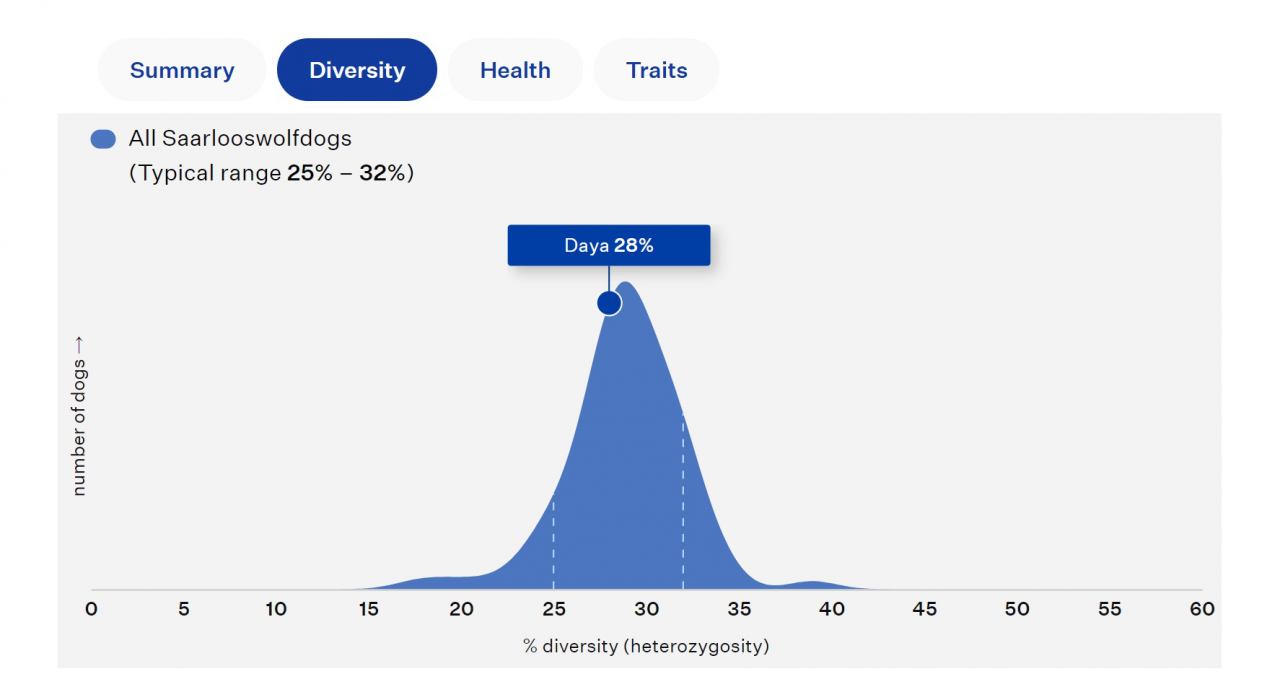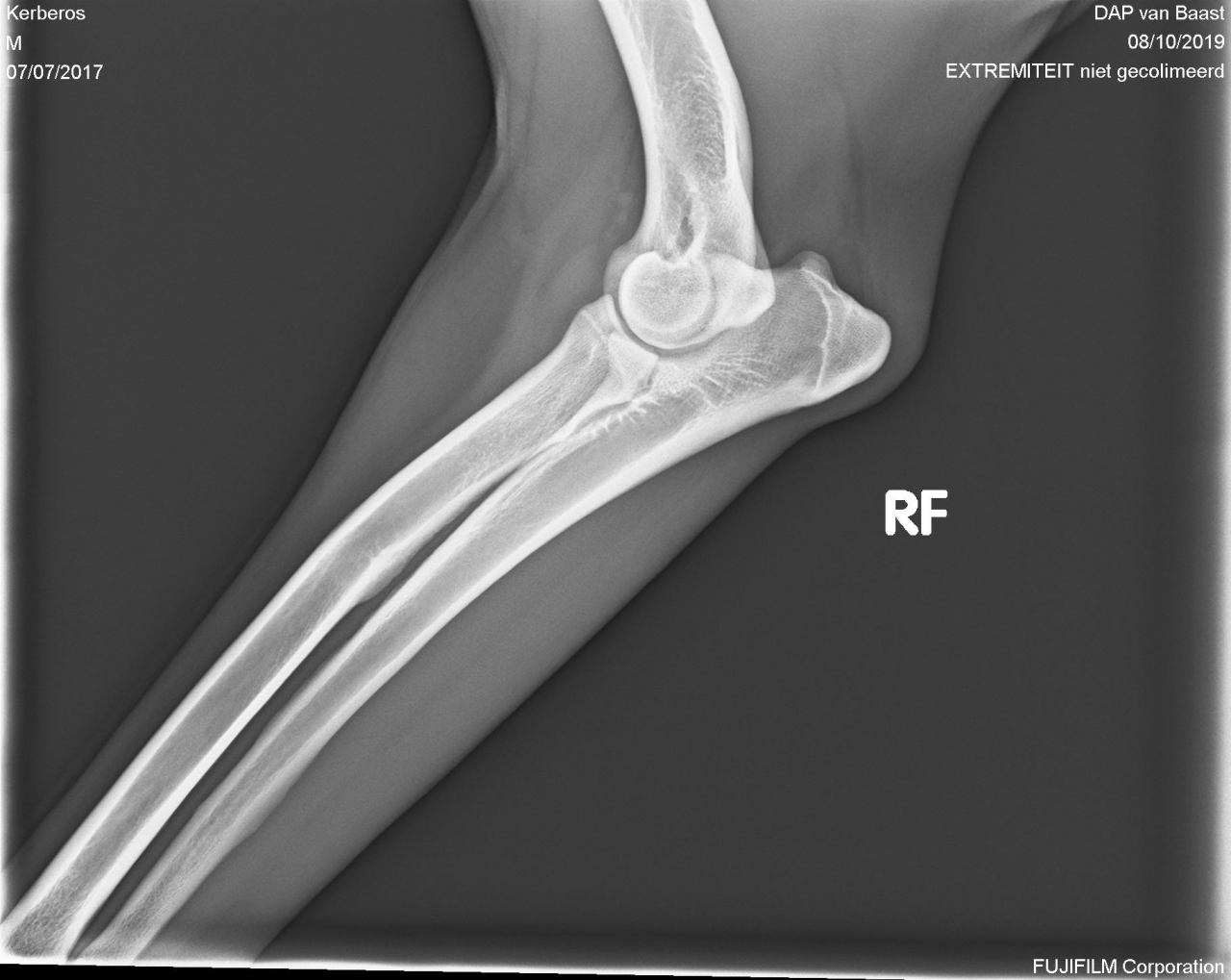

Health & Wellbeing
A problem is an opportunity for you to do your best
The Saarlooswolfdog is a young and relatively healthy breed compared to other dog breeds. Ages up to 14 years and over are no exception.
Problems within the breed do occur and good breeders do everything in their power to prevent disorders from popping up.
An overview of conditions we take into account.

MyDogDNA - Genetic Diversity between dogs based on DNA
1. Breeding rules & wellbeing
1.1 Inbreeding
A female cannot be mated to her grandfather, brother, son, grandson or halfbrother.
1.2 Diversity
A combination of two parents is allowed 1 time, a 2nd time is possible in case of a small 1st litter (1-2 pups) in consultation with the breed club.
1.3 Males
- The minimum age of the male should be at least 24 months old at the day of mating;
- A male can only have 1 successful mating per 12 months and a total of 3 successful matings in its lifetime. A successful mating is a litter from which at least 1 alive puppy is registered in a FCI recognised breed registry. Artificial insemination counts as a mating and is only possible when a male already has descendants;
- Cryptorchid and monorchid males i.e. with one or no testes are excluded from breeding.
1.4 Females
- A female cannot be mated before the day she reaches 24 months of age;
- A female who has not had a litter, cannot be mated after the age of 7 years (84 months);
- A female who has had a litter, cannot be mated after the age of 9 years (108 months);
- A female cannot be mated after the day she has had her 3rd litter;
- A female cannot be mated when this means there is less than 12 months between 2 litters in a row;
- Pregnant females deliver in a home environment at the breeder’s house;
- When a second litter is also born by cesarean (sectio caesarea), the female can no longer be used for breeding.

MyDogDNA - Genetic Relationships between dogs based on DNA
3. Mandatory health testing
3.1 Degenerative Myelopathy (DM)
Both parents of a combination are tested before mating. Combinations can be free x free or free x carrier. Affected dogs are excluded from breeding.
A progressive disorder affecting the spinal cord, causing the nerve fibers to deteriorate, typically between 5 and 8 years of age. In the course of a few months up to a year, a loss of function in the hind legs due to muscular weakness can be seen. Inheritance is autosomal recessive and can only appear when a dog has inherited the mutated gene from both parents. For this condition, there is a genetic test available and by combining dogs that are tested free, or only free dogs with carriers, affected dogs can be prevented.
3.2 Pituitary Dwarfism (Dw)
Both parents of a combination are tested before mating. Combinations can be free x free or free x carrier. Affected dogs are excluded from breeding.
A disorder in the pituitary gland, an endocrine gland attached to the base of the brain, which affects the production of growth hormones, influencing growth and the skeletal development of a dog. Inheritance is autosomal recessive and can only appear when a dog has inherited the mutated gene from both parents. For this condition there is a genetic test available and by combining dogs that are tested free, or only free dogs with carriers, affected dogs can be prevented.
3.3 Hip Dysplasia (HD)
Both parents of a combination are min. 18 months - preferably 24 months - old when tested for HD before mating.
Combinations can be HD-A x HD-A, HD-A x HD-B.
Dogs with HD-C, HD-D and HD-E are excluded from breeding.
A disorder in the hip joint, causing a deviating shape (dysplasia) of the joint with cartilage wear, instabilty of the hip and even arthrosis as a result. HD is multifactorial (= a combination of causes) so partly inherited, partly circumstantial (trauma, nutrition, metabolism, obesity, excess strain as a puppy/young dog, ...) and partly bad luck. By combining dogs with good hip scores, affected dogs can be prevented.
3.4 Elbow Dysplasia (ED)
Both parents of a combination are min. 18 months - preferable 24 months - old when tested for ED before mating. Only dogs with ED score 0/0 can be used for breeding.
A collective term for a number of disorders in the elbows, causing a deviating shape (dyspasia) of the joint, surfacing as early as 4 months of age, resulting in pain and lameness. ED is multifactorial (= a combination of causes) so partly inherited, partly circumstantial (trauma, nutrition, metabolism, obesity, excess strain as a puppy/young dog, ...) and partly bad luck. By combining dogs with good elbow scores, affected dogs can be prevented.

X-ray of the elbow - Kerberos' elbow dysplasia (ED) photo
3.5 Eye diseases
Both parents of a combination are at least 22 months old when tested for inherited eye defects before mating. Max. validity of the test is 12 months. Dogs who have not been cleared are excluded from breeding.
There is no genetic test for heriditary eye diseases in the Saarlooswolfdog breed. Dogs are therefore screened at a special ECVO eye examination, performed by a licenced ophtamologist (eye specialist) who is recognised on a European level.
By combining dogs with multiple perfect eye scores (= all clear), affected dogs can be prevented, but without a genetic test there is no guarantee.
> Read more about the ongoing PRA, Cataract, RD and Epilepsy research project <
- Progressive Retina Atrophy (PRA)
A collective term for a number of disorders in the cornea, causing it to deteriorate and resulting in a partial or complete blindness.
- Cataract
A disorder in the crystalline lense, causing an unusual cloudiness of the lense and resulting in partial or total blindness. There is a distinction between congenital and non-congenital cataract. Congenital does not have to be genetic or hereditary, but it can be.
- Retinal Dysplasia
A disorder in the retina and choroid, causing folds or rosettes (round clumps) of retinal tissue or retinal detachment and resulting in reduced vision or total blindness.
- Persistent pupillary membranes (PPM)
A disorder where the solid sheet of mesodermal tissue - where every dog is born with - to form the pupil in the eye did not dissapear completely. Strands of it become attached to another surface of the iris, lens or cornea of the eye, causing clouded corneas, abnormal iris movement due to lack of light entering the eye and loss of vision.
- Distichiasis / Ectopic cilia
A disorder causing one or multiple eye lashes to protrude through the hairless eyelid margin or the lining of the eyelid, resulting in irritation or even damage to the cornea.
- Corneal Dystrophy
A disorder in the cornea of the eye, which becomes opaque and no longer clear due to the build-up of cholesterol or calcium deposits.
There are three different types of corneal dystrophy, classified according to the layer of the cornea in which the disease occurs.
* Epithelial corneal dystrophy: The outer, most superficial layer or epithelium of the cornea is affected;
* Stromal corneadystrophy: The middle layer or stroma of the cornea is affected. Also known as macular corneal dystrophy;
* Endothelial corneal dystrophy: The inner layer of the cornea or endothelium is affected.
A genetic or hereditary cause is assumed, but high cholesterol and calcium levels, gender and age can contribute to this disease, so it need not be strictly hereditary.
- Lens Luxation
A condition where partial or complete displacement of the lens occurs due to a weakening of the lens ligaments, the tissue that normally holds the lens in place between the iris and the retina. A forward displacement of the lens causes an increase in pressure in the eye, with a high risk of glaucoma or green cataract and blindness as a result. Lens luxation usually appears at the age of 3 to 5 years, but can also be a sign of old age.
3.1 Epilepsy
Affected dogs are excluded from breeding and bloodlines with an elevated risk up to the 2nd degree are not combined.
A disorder of the nervous system causing a temporary short-circuit of the electrical activity in brain cells, resulting in strokes or repetitive epiform seizures, loss of conscienceness, muscle cramps, foaming at the mouth or defecating. The first seizure usually occurs between the age of 6 months and 5 years and there is a distinction between idiopathic epilepsy and structural epilepsy.
- structural epilepsy
The cause of structural epilepsy can be found in construction or acquired disorders, such as a virus, brain damage, stroke or lack of oxygen at birth, which are non-heriditary.
- idiopathic epilepsy
When the cause of epileptic seizures cannot be attributed to a certain neurologic or metabolic disorder, we call it idiopathic epilepsy. A suspected or sometimes proven heredity plays a part in its development. There is no genetic test for this form of epilepsy in the Saarlooswolfdog breed. Inheritance is is polygenetic recessive, which that multiple genes influece the development of the disease. This makes the selection for breeding difficult. Through a sound risk analysis of bloodlines in parents and by not matching two lines with possible heriditary epilepy, affected dogs can be prevented, but without a genetic test there is no guarantee.
> Read more about the ongoing PRA, Cataract, RD and Epilepsy research project <

3.7 Ethanolamine-phosphate cytidylyltransferase (PCYT2)
A form of Spastic Paraplegia, a serious neurological condition, where certain substances in nerve cells, eye retinal cells and brain cells break down the cell wall, causing them to deteriorate, resulting in the gradual and progressive failure of certain bodily functions.
Symptoms:
- sight: night blindness to full blindness, repetitive uncontrolled eye movement (Nystagmus), PRA-diagnosis, Cataract-diagnosis;
- gait/movement changes: lack of coordination (Ataxia) incl. wobbling, drunkman's walk, swaying gait, head tilting, tremors & shaking, spreading fore- and hindlimbs, sagging feet/stance, difficulty climbing stairs, not able to gallop and run, not able to walk in a later stage, circling to orientate oneself;
- behavioural changes: confusion, dementia, stereotypical compulsive acts, restlessly walking in circles, aggression towards owners & dogs, no longer being housebroken or uncontrolled defecation, loss of concentration or no longer able to perform previously learned commandos, leaning against walls, being extremely affectionate and attached;
- Attacks: attacks and seizures, epilepsy-diagnosis;
- Other: Jaw cramps and loss of weight - especially in the head, extreme hunger (Polyphagia), increased intake of fluids (Polydipsia), difficulty swallowing (Dysphagia), skin problems, issues with controlling body temperature, loss of scent.
Saarlooswolfdogs with suspected PCYT2 may have multiple / all symptoms or only 1 or 2 symptoms.
- in other breeds: inceased nervousness, twitches in the face and ears, amble gait instead of regular walking/trotting, crossing of limbs, nausea and vomiting, affected females show cannibalism towards their puppies, tendency to autoaggression, extreme gnawing on paws.
Inheritance is monogenic autosomal recessive and the disease can only manifest itself when a dog has inherited the gene from both parents. The mutation causing this condition has only recently been discovered and a genetic test is under development. Until then a sound risk analysis of bloodlines in parents and by not matching two lines with possible PCYT2, affected dogs can be prevented. In future, combinations can be free x free or free x carrier. Affected dogs are excluded from breeding.
> Read more about the ongoing PCYT2-research project <
3.8 Midline Field Defects
A collective term for congenital problems that occur along the vertical axis of the body, resulting in various abnormalities including but not limited to brain defects, spine defects, heart defects, genital/anus defects, sacral defects, unusual kidney development, defects of the head, face, jaw, back, tail and feet (such as clefts, adverse hair lines on the head or face, skindimple on the back, tail-kink, toe malformation, ...)
An hereditary basis is suspected but the mechanism has not yet been determined. A connection between immunomodulatory, antiparasitic and certain antimicrobial therapies during gestation has already been established. There is no genetic test for midline field defects. Inheritance is thought to be multifactorial recessive or polygenetic. This makes the selection for breeding difficult: the advice* is to exclude affected dogs from breeding and not repeat the same parent combination. Through a sound risk analysis of bloodlines in parents and by not matching two lines with possible midline field defects, affected dogs can be prevented, but without a genetic test there is no guarantee.
*University of Ghent, Faculty of Veterinary Medicine, Dept. of Small Animals - dr. D. Paepe.

Sources:
Evidence for an autosomal gene regulating the midline, Multiple midline defects following gestational administration of medication, Juvenile renal disease in dogs, Kidney dysplasia in dogs, Comparative pathology of canine nephropathies, DNA sequence variants in dogs and grey wolves (1), correction to DNA sequence variants in dogs and grey wolves (2).


